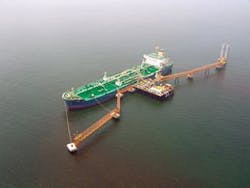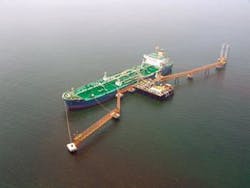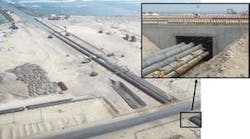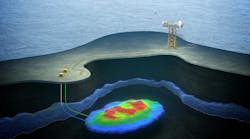Alternative loading concept a success
Gas from Peru’s Camisea project is traveling across the Andes to a fractionation plant on the coast at Pisco. Since summer 2004, liquid petroleum gas processed at the plant flows through subsea pipelines directly to tankers berthed 3 km offshore. The project partners chose the subsea pipeline option over a conventional loading jetty to minimize disruption to local fishing, the environment, and tourism, and to reduce the overall project cost.
The project partners - operator Pluspetrol Resources, Tecgas, Hunt Oil, SK, Sonatrach, and Grana y Montero - are extracting natural gas from the Cashiriari and San Martin fields in the Camisea region of central Peru. They export most of the production throughout the Americas. The partners decided to ship out the heavier constituent parts as LPG, which entailed construction of a dedicated fractionation plant near Pisco on Peru’s Pacific coast.
In this region, the coastline is largely flat desert, exposed to oceanic swells from the southwest and tsunamis triggered by deep-sea earthquakes. The Paracas peninsula south of Pisco provides the only natural breakwater, hence the choice of this location for the fractionation plant. However, Paracas is also a protected nature reserve, a fishing region, and a regular stop-off point for cruise liners.
Following pressure from local authorities, lobby groups, and financing banks, the partners reduced the visual and local traffic impact of a jetty-based LPG transfer operation. This led to an alternative subsea loading concept ITP Interpipe proposed.
The Camisea fractionation plant is 1 km inland and can deliver products for pipeline loading at a rate of 30,000 bbl per hour to marine tankers berthed 3,057 m offshore in 15-m water depth. Products are sent through two parallel, 4-km pipelines, the first kilometer of which traverses the beach. These comprise:
- Two 20-in. cryogenic, insulated, pipe-in-pipe systems (within a 24-in. carrier pipe), plus riser attachment, transporting butane and propane
- One non-insulated 24-in. naphtha line with riser
- One non-insulated 10-in. diesel line with riser
- One power/data communications umbilical.
ITP, with the support from JP Kenny, designed all elements of the bundles.
The insulation medium is ITP’s patented microporous Izoflex material, supplied as panels, which wrap around the inner pipe and fit in the outer pipe. According to ITP’s Pierre Ollier, the major concerns for this project were avoiding freezing of the outer pipe, and delivering gas to end-users at pre-agreed temperatures.
“During transportation on the tanker, permanent boil-off takes place, so the colder the incoming liquefied gas can be, the less the Camisea partners will lose.”
For the main offshore stretch, JP Kenny selected DNV OS-F101 as the optimum design code for the LPG temperature (-45° C). JP Kenny adopted ASME codes 31.4, 31.5, and 31.8 - more typically applied to refinery process pipe applications - for the onshore sections, including road crossings.
For the inner, production pipe, the end bulkheads and field joint half-shells, the team opted for low-temperature carbon steel exhibiting the required toughness at temperatures down to -60° C.
To limit LPG boil-off to a minimum, insulation of the entire 4-km offshore section had to incorporate a U-value of 0.35 W/m2/K. “Our previous best performance for a subsea pipe-in-pipe insulation was 0.55 W/m2/K, on Elf’s Tchibeli field offshore Congo,” Ollier points out.
ITP also designed and installed the pipe fabrication shop on a piece of land 2 km from the planned offshore start-point. It applied two different field joint designs. One featured half shells to join pre-fabricated pipe-strings and end bulkheads. The other, which butted the inner and outer pipes, made up the pre-fabricated pipe strings on site. The partners joined these together using low temperature weld procedures developed with TWI in the UK.
The partners pre-fabricated the pipe-in-pipes on site with the local contractor, including insulation and insertion of 12-m-long stalks at a rate of 20 joints per day. The field jointing operation consisted of welding the inner pipe, made from X-65 grade carbon steel; X-raying the weld; insulating the remaining uncovered part; sliding on the outer (X-70 steel) pipe; and finally welding the outer pipe.
Skanska (from Argentina) built a 3-km railtrack to transport the pipeline bundles in a 5,000-tonne flat pack to the beach-front. It featured a a large bending radius outside the site. The company also dug a tunnel beneath the existing coastal road to avoid interference with local population traffic. Onshore, the stretch connecting the fractionation plant to the landfall was assembled in a trench and buried to a depth of 1.5 m.
Chilean contractor Belfi excavated the 3 m wide trench for the offshore pipeline route to a depth of 2 m. Belfi also designed and installed the offshore loading berth, under supervision from Paragon Engineering in Houston, the client’s main engineering contractor for the project.
Land & Marine installed the offshore lines using an off-bottom towed method in one pull, via a linear winch mounted on an anchored pull-barge, built in Lima. The company managed this pulling operation and installation of tie-in spools on the berthing dock.
Out at sea, divers connected the pipe-in-pipe tie-in spools to the risers by means of tightened flange bolts, applied with hydraulic tensioning systems. Special shrouds ITP designed also protected the flanges against heat loss and local ice formation.
Following trenching, the partners backfilled the pipelines to provide a 1-m-deep cover. They used a clamshell dredging technique applied from 2.5 km offshore to avoid disturbance to local sediment.
Prior to installation, the partners conducted soil liquefaction analysis to ensure that the backfill material would not liquefy in response to a tsunami, causing the pipes to break free of the subsea trench. Operational contraction of the pipe-in-pipe system at the tie-in to the risers was less than 600 mm, while contraction at the tie-in to the onshore plant was less than 150 mm.
Each of the parallel offshore pipelines has a continuous annulus, which bulkheads seal at the ends. This feature ensures correct distribution of stress between the pipes, in turn keeping the loads low and limiting the need for large spool pieces. As this is one of the world’s most seismically active areas, the bundles and associated fittings can withstand a 200-year return earthquake with an acceleration of 0.6 g. The system has a design life of 35 years, the fatigue analysis derived from the DNV RP-C203 design code.
JP Kenny has made provision for pigging the inner pipeline for inspection purposes. A pressure gauge ensures control of the system’s integrity - the annulus pressure between the two pipes. Subsequent measurements also have confirmed that the Izoflex installation is delivering the required level of insulation.
From the start of the project to first LPG shipment last July, was 21 months. According to ITP and JP Kenny, they have achieved a 30-50% cost reduction for the subsea pipe installation, compared with a traditional offloading jetty solution involving pipes on a trestle.
In this location, the scale would have had to be extra outsize to counter the impact from local seismic events. And at 20 m subsea, the pipelines are deep enough to allow unfettered crossing by small fishing boats close to the shore.
For the next phase of the Camisea development, Hunt Petroleum is pursuing an LNG terminal on the Peruvian coast not far from the Pisco fractionation plant.
It is also possible to transport LNG in subsea pipelines, although the U-value of the insulation would be three times better than the LPG pipelines because LNG is transported at much colder temperatures (-160° C), Ollier says. For LNG projects, ITP has developed an LNG subsea pipeline, which DNV and ABS certified.
Reference
The 28th Annual Offshore Pipeline Technology Conference, Amsterdam, March 2005.







